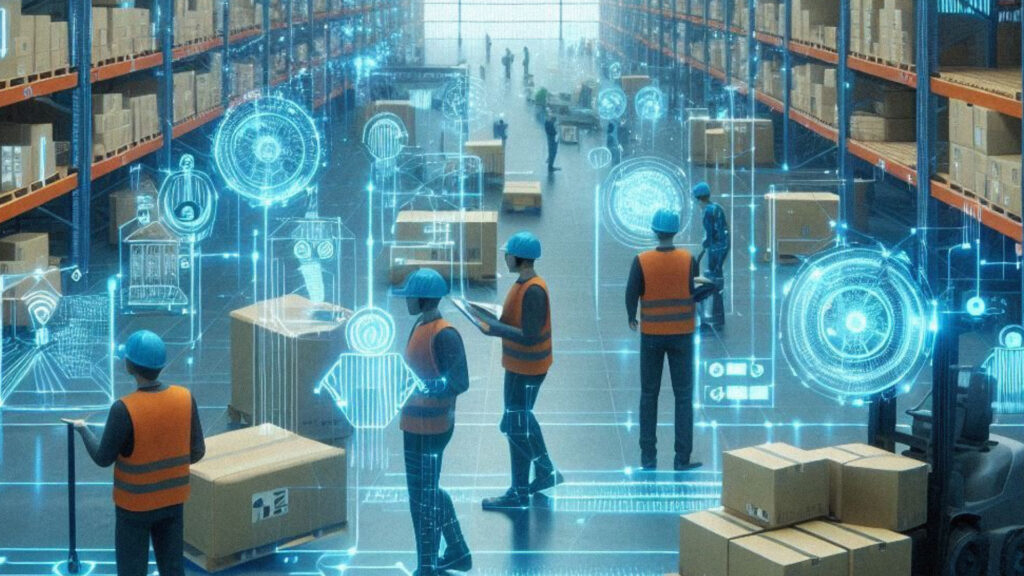The warehousing industry has been a cornerstone of global supply chains for decades. In today’s fast-paced global economy, efficient warehousing is more crucial than ever! Yet, many warehouses still grapple with age-old challenges: manual processes prone to errors, inefficient inventory management, and the struggle to forecast demand accurately. These issues lead to increased costs, delayed shipments, and dissatisfied customers. However, rapid technological advancements, particularly Artificial Intelligence (AI), are already transforming this traditional sector.
How is AI used in a warehouse environment?
AI is no longer just a buzzword in the warehousing sector – it has triggered a paradigm shift. By integrating AI into warehouse operations, companies are achieving unprecedented optimization and efficiency. Let us explore some of the ways by which AI is revolutionizing the industry:
Guiding Decision-Making: AI systems can analyze vast amounts of data from multiple sources, including sales numbers, inventory levels, seasonal trends, supplier information, and external factors like weather patterns and industry indicators. This comprehensive analysis enables warehouse managers to make more informed decisions about managing inventory, resource allocation and devise relevant strategies.
Optimized Space Utilization: AI systems can analyze product dimensions, storage requirements, and historical movement patterns to suggest optimal storage configurations. This maximizes available space and improves slotting and picking efficiency.
Real-time Inventory Tracking: With AI systems and Internet of Things (IoT) sensors, warehouses can maintain an accurate, real-time view of their inventory. This reduces discrepancies, minimizes lost or misplaced items, and enables more precise fulfillment.
Intelligent Demand Forecasting: Since AI systems analyze vast amounts of data, including historical sales figures, variability by time of year, economic signals, and even social media sentiment, they can predict future demand with unprecedented accuracy. This allows warehouses to stock the right products in the right quantities.
Dynamic Inventory Optimization: AI systems can automatically adjust inventory levels based on real-time data and forecasts. This ensures that fast-moving items are always in stock while slow-moving items don’t occupy excess space.
Automated Reordering: AI systems can trigger reorder points based on demand forecasts, lead times, and current inventory levels, ensuring a smooth supply chain without manual intervention.
Markdown Optimization: For products nearing the end of their lifecycle, AI systems can suggest optimal markdown strategies to minimize losses and clear inventory efficiently.
While warehouses are aware of their operational challenges, they often overlook AI’s potential. The misconception that AI is solely about language models like ChatGPT prevents them from realizing its broader applications in optimizing warehouse processes. However, the warehouses that recognize the value of AI and implement it into their operations end up reaping substantial rewards. Also, AI offers a seamless integration with existing systems, enhancing their capabilities without the need for a complete overhaul.
Forming a tag-team with AI in warehouses is another exciting technology, Digital Twins.
What is a Digital Twin?
Digital Twins bridge the physical and digital worlds by creating a virtual replica of a physical warehouse, including its layout, inventory, equipment, and processes. They offer unprecedented visibility and control over warehouse operations. Digital Twins can monitor the warehouse in real-time using 3D visualization. Warehouse Managers can see the location of every item, the status of each piece of equipment, and workers’ movement in real time.
The Digital Twin can constantly analyze operations, identify inefficiencies, and suggest improvements. This could involve optimizing picking routes, adjusting inventory placement, or re-configuring workstations.
Digital Twins can also be used for Scenario Planning. Before implementing changes in the physical warehouse, warehouse managers can test different scenarios in the Digital Twin. This allows for risk-free experimentation with layout changes, new processes, or equipment placement.
Also, new employees can be trained in the virtual environment of the Digital Twin, allowing them to learn processes and navigate the warehouse layout without disrupting actual operations.
The Benefits of using AI and Digital Twins Together
The Benefits of implementing AI systems coupled with Digital Twins in a warehouse can be substantial:
✔ The optimization using these technologies can significantly reduce the time required for various warehouse processes, from receiving to stacking to picking to shipping.
✔ By minimizing errors, optimizing inventory levels, and improving resource allocation, operational costs can be cut significantly
✔ Faster and more accurate order fulfillment will lead to happier customers and fewer returns
Technologies such as AI and Digital Twins are no longer just an option but a necessity for warehouses aiming to stay competitive in the modern business landscape. Thanks to their transformative power, the future of warehousing is bright. By embracing these technologies, businesses can gain a competitive edge, improve their bottom line, and stay ahead of the rapidly evolving warehousing landscape.
If you want to know how to leverage AI systems and Digital Twins in your warehouses and gain significant efficiencies, please get in touch with us to learn more.
